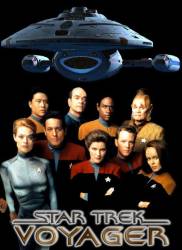Continuity mistake: When Harry uses the scanning tool, the lights alternate between flashing from top down to bottom up and back between angles.

Star Trek: Voyager (1995)
1 continuity mistake in Memorial - chronological order
Continuity mistake: As Starling prepares to launch the timeship from the bay behind his office, there is a shot of the exterior of the ship. In the background of this shot, there is a white wall on the right. This wall carries the company name and logo. However the name is misspelled here as Chronowerks, instead of Chronowerx as was shown on the outside of the building and behind Starling and Janeway when they were in the office.
The Doctor: Watch your tongue... Or I'll remove it.
Trivia: Rain Robinson has a model of a DY-100 on the window sill in her office. In 1996 (also the year this episode is set), Kahn left Earth in the SS Botany Bay, a DY-100 class starship.
Join the mailing list
Separate from membership, this is to get updates about mistakes in recent releases. Addresses are not passed on to any third party, and are used solely for direct communication from this site. You can unsubscribe at any time.
Check out the mistake & trivia books, on Kindle and in paperback.




Answer: If you include the original Star Trek series (1966) then there are several. The communicators used in the original series were before (and said to inspire) mobile phones. We currently do have teleportation technology but it currently only works on things the size of a few molecules. A "Cloaking device" also exists; it's a fabric that bends light through it, though it currently only works in infra-red. The Hypospray is real and was patented in 1960 - six years before the original series aired - it's actually called the Jet Injector. Faster Than Light travel is still a few decades off, but there are several real-world theories that look promising, including one that is remarkably similar to the method used in the Star Trek Universe called the Alcubeierre Drive that involves manipulating spacetime ahead and behind the ship and the ship "riding" it. Medical techniques and technologies have also advanced considerably; prosthetics particularity and we routinely have robots performing surgeries where absolute precision is needed. The "Shield" used in the series have a few primitive versions around. The Phasers used in the series are used but are not very powerful (nor will they ever be as powerful as the Star Trek version the laws of physics gets in the way) but rail-guns (using magnets to spin then propel a projectile) and particle accelerators like the Large Hadron Collider have been around for a while. The Replicator would require a nuclear fusion reactor and a nuclear fission reactor in something the size of a large oven and the Holo-deck wouldn't work at all based on our current understanding of physics so those are both still science fiction at the moment, but who knows!
Sanguis